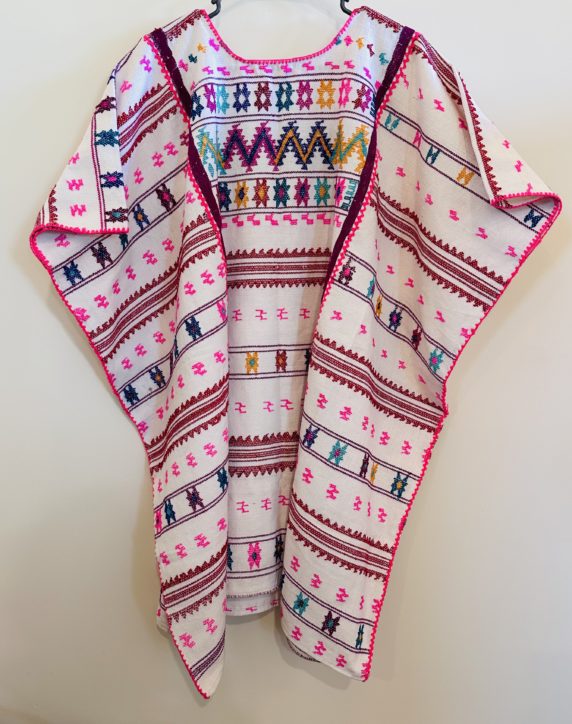It’s festival season in Teotitlan del Valle. It was a full moon, a large globe of yellow light illuminating the path and all who walked it. On Christmas Eve baby Jesus is carried on a pillow through the winding cobblestone streets by the patron of the *last posada. He is followed by a litter holding statues of Mary and Joseph shouldered by four young women.
The procession is flanked on one side by men, the other side women, each carrying lit decorated beeswax candles adorned with handmade wax flowers. Firecrackers boom out in front. A man swings a copal incense burner. The aroma is sweet, intense. Children and adults tweet whistles. The drummer keeps the pulse of the crowd throbbing.
We pick up people along the way to join in. Some stand at street corners or in doorways. Even the smallest of children participate. Early acculturation to custom and tradition.
The timing is precise. The procession must arrive at the church exactly at 10 p.m. for the evening mass to return the figures to their rightful resting places for another year, when the cycle will be repeated again with different actors.
My son, sister and brother-in-law are here and I’ve had the joy of being a tourist in my own town for the last few days. This night, we got to the house of the patron a little after 7 p.m. to learn that the procession that would leave the house to get to the church wouldn’t begin until 8 p.m.
Being the wonderful, hospitable people that Teotitecos are, we got invited in to see the creche and the blessing ceremony before the group gathered to walk the streets of the village.
My sister, a flautist, struck up a conversation with the band leader who invited her to join them at a special morning band ceremony on December 31 that will welcome in the new year. Start time? 4 a.m.! I’m not sure Barbara is going to make it.
Tradition in this village is to have a family meal at midnight after the mass ends to welcome the birth of Dios Niño. This is a feast of tamales, wine, mezcal, salad, chicken, stuffed pork, turkey or whatever other favorite entree the family likes. There may be beans, rice, fresh vegetables from the fields, ponché (like a sweet fruit cider), fresh fruit and an extravagant dessert.
There is no big festival meal served during Christmas Day here like in the USA. Families relax, stroll, play games. So, I asked Josefina if she would prepare a carry out. Roasted chicken spiced with salsa roja, mixed with carrots, green beans, squash and potatoes, served with organic rice and beans. Surprise, Lupita shows up with a gift of handcrafted chile rellenos stuffed with chicken.
We finished on the rooftop terrace with wine and a three-hundred-and-sixty-degree view of the Tlacolula Valley. The red sun vanished in the west.
*The Last Posada: La Ultima Posada, is actually on December 23, when Mary and Joseph move to the Casa de la Patron for the final evening before the birth of Jesus. The baby appears at this house on December 24, is cradled by the woman of the household, then is held by the patron under a canopy as the procession leaves the house and moves through the village to the church. This December 24 event is called La Procession.
Technical issues: My USB internet connection is REALLY slow these last days. It takes about 30 minutes to upload one photo! So this is a delayed post. Lots of intervening activities since I wrote this: The radish festival, a trip to Hierve El Agua, and a mezcal exploration to the remote mountain village of San Juan Del Rio. More to come.






































































How to Navigate Oaxaca’s Radish Festival: Norma’s Tips
Noche de los Rabanos, the Night of the Radishes, in Oaxaca, Mexico, always on December 23 each year, draws huge crowds. The entire zocalo of the city is taken over by giant carved red roots depicting traditional scenes of Oaxaca’s cultural and indigenous life.
There was a new category this year which I can loosely translate as free style. It attracted a lot of young participants who carved phantasmagorical creatures that especially captured the attention of the little ones.
There are also two other categories, one for dried flowers and another for the use of corn husks (totomoxtle in Nahuatl) to create scenes. But it is the radishes that people love.
The number of visitors, coupled with triple the number of vendors, plus all the families of the radish carvers, means that the area is packed with people and hard to navigate.
This year was no exception. So I’m writing this now post-event to give you a heads-up for the future. GO EARLY.
The displays, along the 360 degree circumference of the zocalo, are ringed by a large raised walkway that is gated and protected by guard rails. No one can gain entry to this walkway until 5:00 p.m. when the Radish Festival officially opens. There are guards everywhere to guarantee this.
So, people begin to line up early and by 3:00 p.m. when we got there this year, there were several hundred people in line waiting for the opening bell.
At 3:00 p.m. we were able to peer over these guard rails to see the displays and get some pretty decent camera shots. The designers of the dioramas were constantly obstructing the views with continuous spraying of water to keep the radishes fresh.
The judges were not passing through until close to opening time and everyone wanted their fresh vegetable displays to look perfect. Of course, many of the veggies were not obedient. It was a hot day with lots of wilted leaves and roots.
Most of the time we had to wait our turn to get up to the rail since people were two or three deep. Many had the same idea as we did — avoid the long lines and get an earlier, though somewhat obstructed, view.
It took us until almost 5:00 p.m. to walk around the circumference of the zocalo to see everything. By then, it was nearly impassable. We finished seeing the last display after going full circle just as the clock struck.
There was my friend Francine, along with a couple of other silver headed visitors, who was admitted early. She was pulled out of the line, she said, and allowed to go as a “grande” or a “senior citizen.” I guess this is the time to be grateful you don’t color your hair.
My recommendation is to get there by 2:00 p.m. The displays won’t be complete, but you’ll be able to get the best, somewhat unobstructed views and you won’t have to wait in line for hours or deal with the crush of the crowd.
On the other hand, if you want a totally clear and raised view of everything, then have your wait. In any case, this is a very fun part of being in Oaxaca this time of year.
Triqui demonstrators on the Zocalo, but the teachers are gone!
Oaxaca is safe. We have a small group of Triqui demonstrators who continue to encamp on a small part of the zocalo, but otherwise everything is clear.
Like this:
6 Comments
Posted in Cultural Commentary, Oaxaca Mexico art and culture, Photography, Travel & Tourism
Tagged folk art, Mexico, Noche de los Rabanos, Oaxaca, Radish Festival, visitor tips, when to go